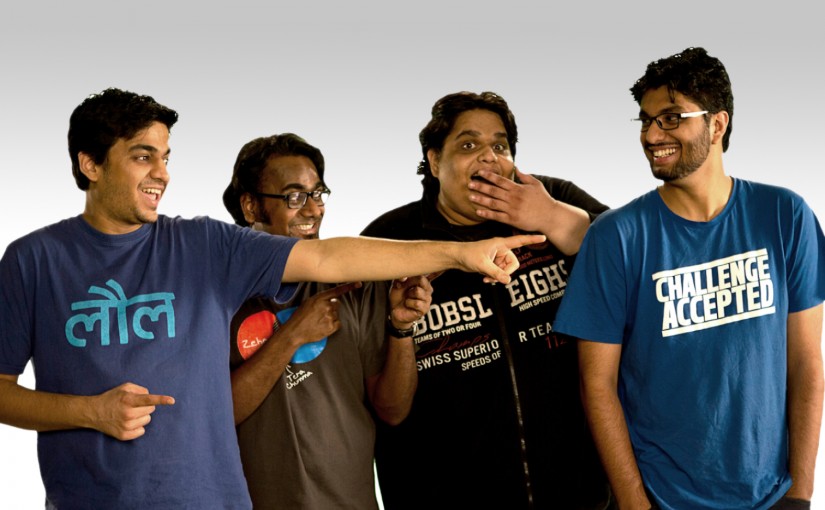Drop us a few lines about the task and we will get back immediately to see we how we can take the discussion forward. Alternately, just pick up the phone and speak with us at +91 9910034330 and we would be happy to help.
- - Do tell us a little about the nature of your business.
- - Be specific about what you’d like us to help you with.
- - Knowing your budget always helps us plan a suitable intervention.
- Blog
‘Blogs- Power to the People’ – so much has happened
-
‘Blogs- Power to the People’ – so much has happened
“How can ‘this’ piece not be on the blog!” I had silently exclaimed to myself. After all ‘this’ is where it all started. A session in the office, an informal prompt and I had penned this first, with my limited understanding, for the company newsletter and it was then republished byExchange4Media.com in Jan 2006. It’s been there since. In the interim, so much has happened…both for me and for the overall social media space.
I am adding the text below as the e4m story didn’t carry links – they help. Do leave your feedback…
Blogs- power to the people – First written July/ Aug 2005; Republished on e4m in January 2006 (Warning: Many things have changed since and the content may read ‘dated’, it is:
Participatory Journalism, they are calling the phenomenon and it’s turning the very concept of journalism, as we have known it, on its head. Yes, we are talking about Blogs – online journals consisting of automatically managed articles and posts (not just text, but also audio and video files) from users, and linking with other such journals to form a global network on the Internet.
So, what’s so exciting about blogs? What makes them so powerful? So unmanageable!
Microsoft, the big daddy, had a brush…
Late last year, Microsoft announced that it planned to launch Microsoft Spaces, online software that would allow people to easily create and manage blogs. A co-editor from one of the most widely read blogs – boingboing – attempting to test the service discovered that in their attempt to perhaps censor content on the service, Microsoft had built in filters (blogger’s don’t like their right to speech curbed) that wouldn’t allowing formation of certain categories of blogs that she attempted to create. Her posts on the blog were critical and by the end of the day, dozens of other blogs were linked to boingboing, picking up the criticism… and adding their own. In the next few weeks, hundreds of other blogs joined in…
Microsoft had finally met its match!
Blogs are the closest one could get to word-of-mouth on a mass platform and people were no longer defenseless against the giant. They had found their voice. Blogs are such a rage because you don’t need to know any software language -it’s simple as punching an email and clicking a button.
Coming back – so, how did Microsoft get heard? What did they use? What else, but a blog!!
Geek blogger Robert Scoble works with Microsoft, and although not a high ranking official within the company, he, however, owns a popular blog Scobleizer on which he leaves comments about happenings in the technology world, particularly about the world inside Microsoft – rather harmless stuff, nothing very intense or significant.
Reacting to criticism from Boing Boing, Scoble presented his view- he agreed with the critics!
No one at Microsoft really dictated what he should speak. His stand helped soften the blows and got people coming back. He also performed the critical task of taking the complaints to the team working on ‘Spaces’, so that they were aware of the issues.
Thousands of blogs linking to his blog were able to read how Microsoft was reacting as he posted comments – they felt heard. Scoble gave Microsoft a ‘human’ touch that it never had earlier.
Blogs are already big in the US – those looking for juiciest bits on the 2004 US elections, first, turned, not to television, but to blogs. Then how is it that we haven’t seen blogs create similar impact in India, yet? It, quite simply, has to do with net usage in India.
Sheer number of Internet users and penetration in the US and other developed economies is way ahead and an available research from the US, conducted in 2004, says that just 2% users actually posted on blogs or maintained there own blogs. In all 11% Internet users visited them. If similar was the trend in India too – though actual numbers in India are much lower- the numbers would not form critical mass to have significant impact on a large scale, yet (other than niches of early adopters, say, the Techies).
Although, quite like the US – which has been on the forefront of the blog revolution and where too over 90% bloggers are said to be below 30 years in age – youth form the major chunk of Internet users in India (68% are between 15-30 years) – the impact that this age group has on enterprise, commerce and political opinion in the US is far higher than in India.
Also, as a global trend, very few bloggers really talk about real issues, concerning business, society and policy, a very significant majority of blogs (over 70%) are personal musings, on a variety of subjects.
There are other factors too – stories from issues raised by those few – but heard voices – are often picked by the mainstream media, further enhancing their impact and fuelling their success (or bloggers would pick an issue from the media and then carry that further). That’s yet to happen here in a big way- though change is making itself felt, slowly but surely, check out Known Turf , which my friend Annie – a journalist – writes…
And, while media can further fuel blogosphere’s success story, Blogs are actually about giving the power to the people themselves.
What makes blogs different from the Internet as we have known it, is that against catalogued information that websites have provided us, blogs are alive and ticking. Blogs are, what the world is thinking and saying RIGHT NOW, uncurbed. So, as it can make products and people, it also holds tremendous potential to destroy.
Indra Nooyi, CFO and President, PepsiCo was recently quoted, out of context, on some blogs and got embroiled in unnecessary controversy. Pepsi had to do damage control by posting her entire speech to derive context. The controversy made global headlines and caused some embarrassment not only to Nooyi and PepsiCo but also to the US as a whole.
Communication professionals have so far relied on the media to carry our inputs and help us make news. Blogs now allow you to reach your audience directly…
High Five – what to do:
– A great tool to track issues
What are people saying about you/ your client in the blogosphere?
Even though there are legal implications for bloggers naming products and companies, but most go ahead and name them anyway- policy and law are also not really in place or clear about what is appropriate and what’s not.
Check out these links to see if a topic, or word, you want tracked has featured. You can see if anyone has linked to a given URL on Technorati. You can also search for key words on Bloglines.
Blogdex
Technorati
Bloglines
– You could also subscribe to RSS (Really Simple Syndication) feeds that aggregate content for you, rather than have to search for it, and deliver either in your inbox or as a webpage:
Bloglines
Feedburner
Firefox
You can also track who’s linking to your blogs by checking comments and through trackbacks.
Do prepare a watchlist of blogs that your stakeholders seem to be linking up to. How influential are these blogs? Survey your amongst your stakeholders regarding blogs that they think are relevant to them. Do they read these blogs and form opinion based upon them?
– Tell clients to set up a blog to gain ongoing feedback and to tell their own story.
See how Vice Chairman, General Motors, Bod Lutz does it
Fastlane
But, hey, do ensure that your client has the time to respond to posts and that s/he/he is wordsmith of sorts – blogs can be time-consuming, and once they must take up the commitment, they must live up to it. (One advice though, many organizations have a clause restraining its employees to Blog – your client could be one such, urge the spokesperson to clarify before you decide to go ahead.)
– Use blogs for research – they are live, reach everywhere and are zero cost.
Great tool in CSR. Reach out in times of calamity or nurture a cause long-term.
Hundreds of blogs (some with doubtful credentials too) came up in wake of the Tsunami disaster.
Here’s one that did a fantastic job reaching out with updates and needs. Many a volunteer burned the midnight oil for weeks.
Tsunamihelp
– Manage a community
A successful reality programme on TV, attempting an interactive format, could do with a vibrant blog.
– Ride a wave – See if you could feature you’re your/ your client’s message or comment in some of the already popular blogs – it’s like owning a shop in a teeming mall, rather than having to locate one on a highway
See Blogstreet India which lists Indian blogs. Rajesh Jain’s technology blog Emergic is among the most visited blogs in India. Also somewhere there on the top is Dina Mehta’s blog that brings out issues from time to time.
Simillary, Top 100
Find the Most influential
See which blogs are people reading. They would appear as links on their pages, as blogrolls- Do avoid
– If you are working for a client, don’t talk about them without an authorization – a controversy could cost you the account.
– Don’t try and manage a livewire crisis through blogs – unless you are sure that you/ your client has support from a vast majority of the audience, and then too, remember, that the small minority’s views can influence some of your support base (In case you do get caught in a blog fire, respond quickly and with a clear action plan.)
– Don’t talk about your company/ client even on your personal blog – a random comment, out of context, could jeopardize the interests of those being mentioned (People have lost their jobs on account of blog comments they left.)
– Don’t get into direct fundraising through blogs, unless your credentials are unimpeachable. Bloggers are wary of fundraisings and you wouldn’t want to get into something that could blemish your client’s reputation
– Don’t leave frivolous remarks on your firm, client or competition. Comments left on blogs are permanently available to anyone who bothers to search
But, there are issues – credibility is a key one – what are the motivations of the blogger who posted a negative comment? Did the blogger have any commercial lures to write a positive comment? Is the blog/ blogger real or fake? How do you counter malicious attacks and propaganda? There are no clear answers that anyone has today. It’s a space that’s changing every minute…
Given that India scene is not really hot yet, could tempt you to say – why bother! But, Blogs are here and how news is formed or reaches the audience would never be the same again. Better to be a leader, than a follower…Disclaimer: Views of authors are personal and do not represent the views of Blogworks, or any of its clients.
-
Contact
conversations@blogworks.in
+91-9910034330 -
Newsletter
-
Social

























